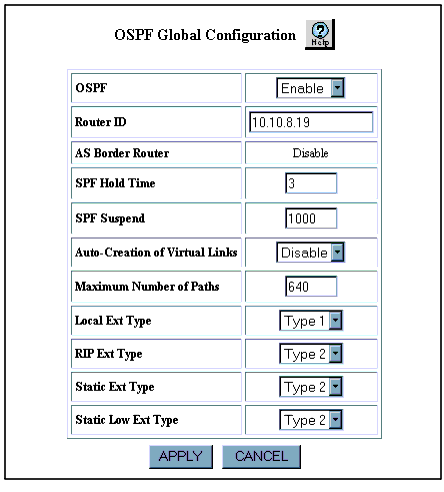|
|
|
To globally configure OSPF using the Web Agent:
The OSPF Global Configuration Web page is displayed in the content pane. See Figure�147.
Figure�147:�OSPF Global Configuration Web Page

| Parameter |
Description |
|---|---|
| OSPF |
Select to enable or disable OSPF globally on your switch. |
| Router ID |
Specify the Router ID on the switch. The router ID is a 32-bit number assigned to each router running OSPF. This number uniquely identifies the router within an Autonomous System. If 0.0.0.0 is used, the router uses the IP address of an interface. |
| AS Border Router |
Displays the Autonomous System Border Router (ASBR) status. The switch automatically detects the ASBR status:
For more information on route redistribution filters, see "Configuring Route Redistribution" in Chapter 12:�Configuring IP Routing. |
| SPF Hold Time |
Specify the minimum number of seconds between SPF (shortest path first) runs. |
| SPF Suspend |
Specify the number of nodes to process SPF runs before suspending. |
| Auto-Creation of Virtual Links |
Enable or disable the function of automating the creation of virtual circuits based on network topology. This feature is Avaya proprietary and only auto creates virtual links on the config. notes. |
| Maximum Number of Paths |
Configure the maximum number of paths used when running OSPF. The default setting is 4096. |
| Local Ext Type |
Specify whether imported local routes are advertised in OSPF with type 1 (internal) or type 2 (external) metrics. |
| RIP Ext Type |
Specify whether imported RIP routes are advertised in OSPF with type 1 (internal) or type 2 (external) metrics. |
| Static Ext Type |
Specify whether imported high preference static routes are advertised in OSPF with type 1 (internal) or type 2 (external) metrics. |
| Static Low Ext Type |
Specify whether imported low preference static routes are advertised in OSPF with type 1 (internal) or type 2 (external) metrics. |
|
|
|